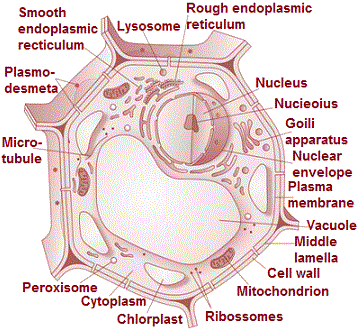The cell wall
A non-living rigid structure called the cell wall forms an outer covering for the plasma membrane of fungi and plants.
Cell wall gives shape to the cell and protects the cell from mechanical damage and infection. Cell wall also helps in cell-to-cell interaction and provides barrier to undesirable macromolecules.
Algae have cell wall, made of cellulose, galactans, mannans and minerals like calcium carbonate, while in other plants it consists of cellulose, hemicellulose, pectins and proteins.
Cell wall of a young plant-cell is capable of growth which gradually diminishes as the cell matures and the secondary wall is formed on the inner (towards membrane) side of the cell.
The middle lamella is a layer mainly of calcium pectate which holds or glues the different neighbouring cells together. The cell wall and middle lamellae may be traversed by plasmodesmata which connect the cytoplasm of neighbouring cells.

Plant cells have a cell wall but animals cells do not have cell wall.
The organisms that have cell walls are plants, fungi, and certain prokaryotes (bacterial type cells).
In the case of plants, The cell walls are mainly comprised of complex polysaccharides (sugar-based polymers) molecules such as cellulose, hemicellulose, and pectin.
The functions of cell wall
The cell wall renders mechanical strength
The cell wall serve as food reservoir
The cell wall maintains the shape of the cell
The cell wall regulates the intercellular transport
The cell wall regulates the expansion of cells
The cell wall provides protection against pathogens
